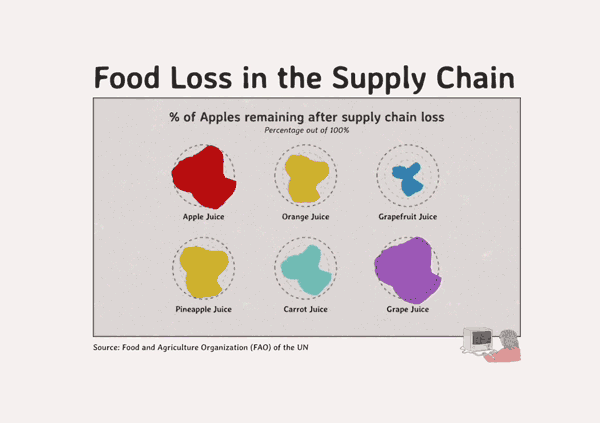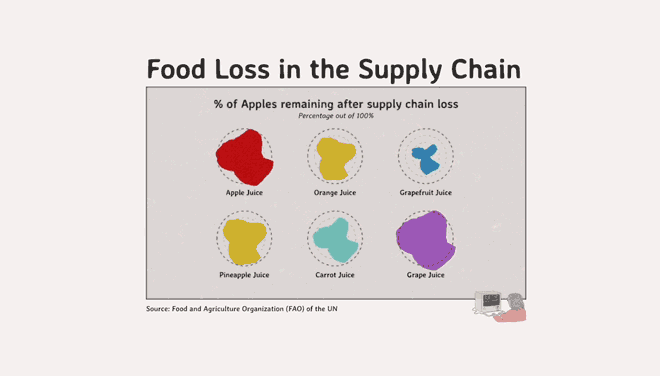Comparing Food Loss Among Fruit In the Supply Chain
Rates of food loss vary among foods, but fruit are particularly nasty culprits, with estimates sitting at about 60%


Food loss refers to the decrease in quantity of food in the supply chain, resulting from decisions and actions made by food suppliers. It's important for “loss” not to be confused with waste; 'loss' occurs before the food reaches the consumer - and can actually be repurposed - while “waste” refers to food that reaches restaurants/grocery stores but still get thrown out.
Rates of food loss vary among different foods, but I found out that fruits and fruit are particularly nasty culprits for food loss. Some estimates sit at about 60% for loss rates among food, and that number sounded enough for me to make a blog post about it.
I decided to graph a few examples of fruit and fruit juices from the Food Loss and Waste dataset just to put the loss in visual perspective.
Food Loss in the Supply Chain
Among all fruits produced, some estimate that almost 50% of crops are being processed as juice
% of Fruit Successfully Processed Into Juice
Utilization Rate (% of Food not Lost in the Supply Chain)A Brief Overview of Fruit Supply Chain Losses
Food loss in fruits and their juices primarily stems from several key areas. I had ChatGPT summarize it:
- Agricultural practices: Improper handling/technique during harvesting can damage fruits, making them unsuitable for sale.
- Transportation and storage: Inadequate storage facilities and logistical challenges can lead to spoilage. Fruits are particularly sensitive to environmental conditions like temperature and humidity.
- Processing inefficiencies: During the juicing process, not all parts of the fruit are used effectively, as we've alluded to. Peels, pulp, etc get thrown out, but innovations in processing could potentially reduce this waste.
- Food is ugly af: Supermarkets and consumers often reject fruits that do not meet certain aesthetic criteria, despite being perfectly edible.
Where Does the 'Lost' Food Go?
During the juicing process, several components of the fruit are typically removed and discarded into landfills - up to 40%. These include peels, pulps, seeds, and the stems and cores, and ends up causing a lot of issues related to food waste.
Although these by-products are rich in nutrients and bioactive compounds, they often are not utilized efficiently. The good thing is that there is a lot of opportunity in redirecting this waste, including:
- Animal Feed
- Composting and Fertilizer
- Bioenergy Production (fermenting fruit pulp and other organic by-products can produce methane)
- Extraction of Bioactive Compounds: Fruit skins and seeds are rich in vitamins, antioxidants, and enzymes)
- Packaging Materials: (cellulose and pectin in fruit peels can be processed into eco-friendly plastic alternatives for packaging)
